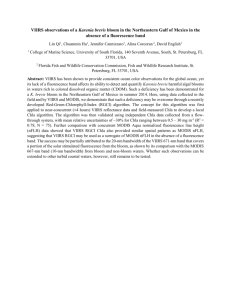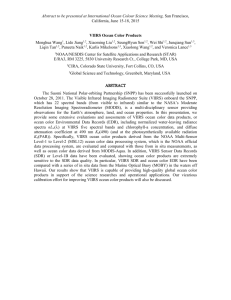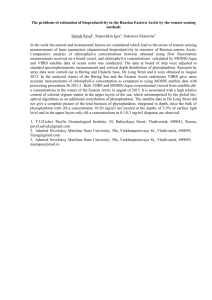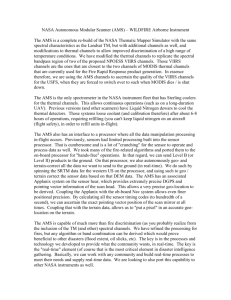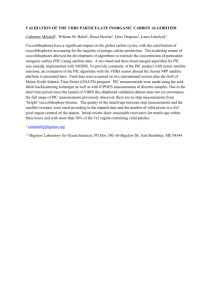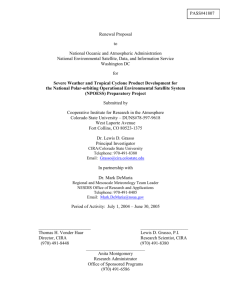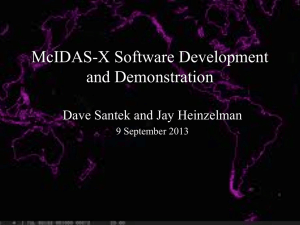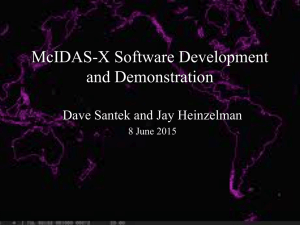The Challenge of VIIRS Imagery in McIDAS-X: How McIDAS Experience Helps
advertisement
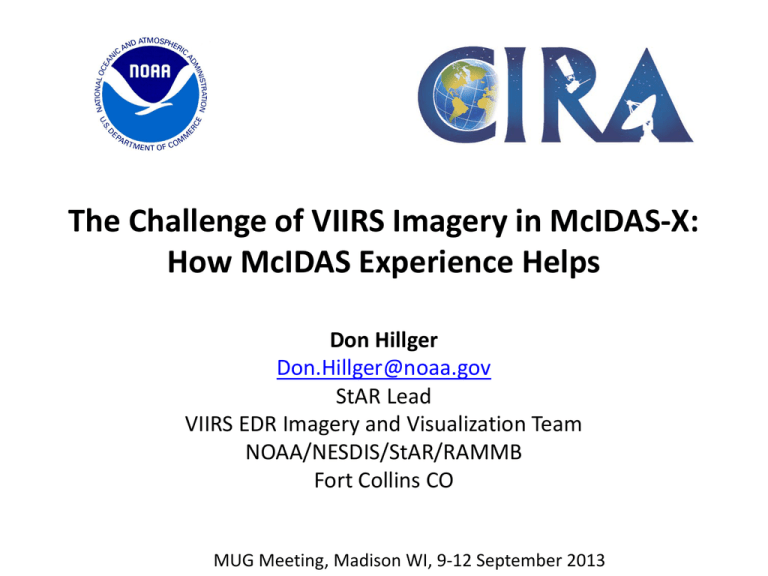
The Challenge of VIIRS Imagery in McIDAS-X: How McIDAS Experience Helps Don Hillger Don.Hillger@noaa.gov StAR Lead VIIRS EDR Imagery and Visualization Team NOAA/NESDIS/StAR/RAMMB Fort Collins CO MUG Meeting, Madison WI, 9-12 September 2013 VIIRS Bands and Bandwidths M1 M2 M3 M4 M5 (B) M6 M7 (G) M8 M9 M10 (R) M11 M12 M13 M14 M15 M16 Central Wavelength (μm) 0.412 0.445 0.488 0.555 0.672 0.746 0.865 1.240 1.378 1.61 2.25 3.7 4.05 8.55 10.763 12.013 DNB 0.4 0.5 - 0.9 Visible Visible / Reflective 750 m across full scan I1 (B) I2 (G) I3 (R) I4 I5 0.64 0.865 1.61 3.74 11.45 0.08 0.039 0.06 0.38 1.9 0.6 - 0.68 0.85 - 0.88 1.58 - 1.64 3.55 - 3.93 10.5 - 12.4 Visible / Reflective Near IR Shortwave IR Medium-wave IR Longwave IR 375 m VIIRS Band Bandwidth (μm) Wavelength Range (μm) 0.02 0.018 0.02 0.02 0.02 0.015 0.039 0.020 0.015 0.06 0.05 0.18 0.155 0.3 1.0 0.95 0.402 - 0.422 0.436 - 0.454 0.478 - 0.488 0.545 - 0.565 0.662 - 0.682 0.739 - 0.754 0.846 - 0.885 1.23 - 1.25 1.371 - 1.386 1.58 - 1.64 2.23 - 2.28 3.61 - 3.79 3.97 - 4.13 8.4 - 8.7 10.26 - 11.26 11.54 - 12.49 Band Explanation Spatial Resolution (m) @ nadir Visible / Reflective Near IR 750 m Shortwave IR Medium-wave IR Longwave IR Notes: M-bands highlighted in pale yellow are available as EDRs, in addition to SDRs. True-color component bands are highlighted in red, green, and blue. Natural-color component bands are noted with R, G, and B. 2 NPP/JPSS data sources • GRAVITE1 (Suitland, 7-hour delay) • NOAA CLASS2 (Asheville, 7-hour delay) – not actively used • Atmosphere PEATE3 (Wisconsin, 7-hour delay) – ADDE server for McIDAS-X – FTP and HTML • Direct Readout (Wisconsin, minimal delay, but provides data only over North America, when the satellite is with sight of Madison) • AFWA IDPS4 (Omaha, near real-time) 1Government Resource for Algorithm Verification, Independent Test, and Evaluation 2Comprehensive Large Array-data Stewardship System 3Product Evaluation and Algorithm Test Elements 4Air Force Weather Agency Interface Data Processing Segment Suomi NPP Imagery and Visualization Team web page http://rammb.cira.colostate.edu/projects/npp/ 4 Suomi NPP VIIRS Online http://rammb.cira.colostate.edu/ramsdis/online/npp_viirs.asp 5 JPSS/Suomi NPP VIIRS Imagery Blog http://rammb.cira.colostate.edu/projects/npp/blog/ Blog maintained at CIRA to highlight capabilities of VIIRS instrument. Designed to provide education/outreach of VIIRS imagery applications. Blog covers wide range of topics: tropical cyclones, severe weather, fire detection, auroras, volcanic eruptions, flooding, snow and ice detection, DNB applications, RGB composites and other interesting high-resolution imagery from VIIRS Beginner’s Guide to VIIRS Imagery Data Curtis Seaman CIRA/Colorado State University http://rammb.cira.colostate.edu/projects/npp/ Beginner_Guide_to_VIIRS_Imagery_Data.pdf 7 VIIRS single granule information VIIRS Lines x Elements Suggested McIDAS-X magnification Size (km) ~550 km x ~3000 km I-bands (full size) M-bands (full size) Suggested McIDAS-X window (~5° x ~27°) 1536 x 6400 768 x 3200** 768 x 1600*** -2 x -4 1 x -2 1 x 1 (with LINE=X 800) or to get center half of granule 768 x 1920 1 x 1 (with LINE=X 640) to get center of granule between outermost bowtie deletions DNB (full size) Suggested McIDAS-X window NCC (from DNB) 768 x 4064 768 x 2032 1 x 1 (with LINE=X 1016) or to get center half of granule 786 x 1600 1 x 1 (with LINE=X 1232) (same size as other bands) to get center portion of granule same size as other bands 768 x 3200** [Same treatment as M-bands] Each granule, ~86 seconds long, or ~556 km along track *Based on an altitude of 833 km **48 scans x 16 detectors/scan = 768 lines ***Based on a McIDAS window as large as most single monitors will display VIIRS granule display in McIDAS-X (band M5 example) Full 90-second granule (768 x 3200) (Bow-tie deletions at each end of SDR granule are filled) Center half of granule (768 x 1600) (Avoids filled-in bow-tie deletion areas at each end of SDR granule) Full 90-second granule remapped to Mollweide projection (in McIDAS-X) 16 M-band detectors per scan (red pixels are bowtie deletion pixels, first one then two lines.) Should be a repeating pattern every 16 lines. Right half Left half 11 Bow Tie Line Deletions Sequential lines missing (M-bands) Lines missing out of 16 lines/scan (M-bands) Elements (M-bands) Number of elements (M-bands) Scan angle Zenith angle 2 1 0 1 2 4 2 0 2 4 1-640 641-1008 1009-2192 2193-2560 2561-3200 640 368 1184 (2x592) 368 640 56°-44.7° 69.4°-52.6° 44.7°-32° 52.6°-36.7° 32°-0°-32° 36.7°-0°-36.7° 32°-44.7° 44.7°-56° 36.7°-52.6° 52.6°-69.4° VIIRS M3 band 2013-06-30 06:03:51 UTC VIIRS M3 band 2013-06-30 06:03:51 UTC with bowtie deletions filled-in VIIRS M3 band 2013-06-30 06:03:51 UTC VIIRS M3 band 2013-06-30 06:03:51 UTC rotated so that north is to the top VIIRS M3 band 2013-06-30 06:02:26 UTC Images of two adjacent granules VIIRS M3 band 2013-06-30 06:03:51 UTC VIIRS M3 band 2013-06-30 06:03:08 UTC VIIRS scientific units (unlike GOES radiances in RAW counts) VIIRS bands Units available from HDF5 via ADDE server (only) Visible / Radiances Reflectances Reflective Thermal / Radiances Brightness Emissive Temperatures Other units in McIDAS Brightness counts Brightness counts Day/Night Band Brightness counts Radiances Reflectances Best to copy the VIIRS images from the server in the units needed, since once separated from the server, other unit scalings are not automatic, but need to be done manually. Commonly used three-color (RGB) combinations of VIIRS bands. Three-color (RGB) Product Red Green Blue True color M5 (0.672 µm) M4 (0.555 µm) M3 (0.488 µm) M10 (1.61 µm) M7 (0.865 µm) M5 (0.672 µm) I3 (1.61 µm) I2 (0.865 µm) I1 (0.64 µm) Natural color VIIRS true-color RGB combination VIIRS natural-color RGB combination North shore of Black Sea (Odessa) VIIRS natural-color image from 24-bit RGB combination (JPG) using COMBINE command VIIRS natural-color image from 8-bit RGB combination (GIF) using AREACOLOR program Northeastern Iraq fires Sensor Data Record (SDR) to Environmental Data Record (EDR) • Ground Track Mercator (GTM) remapping software. – GTM is a remapping of the data, but the same radiances/reflectances/temperatures for Non-NCC bands only. • For NCC imagery, which is derived from the Day Night Band (DNB), there is additional radiance (reflectance) processing Sensor Data Record (SDR) GTM software Environmental Data Record (EDR) DNB (SDR) radiance GTM software plus NCC (EDR) pseudo-albedo At the Day/Night Terminator NCC EDR SDR 11:53 UTC 31 July 2013 During a New Moon NCC EDR SDR Stray light Stray light 06:43 UTC 6 August 2013 NCC Over a Full Lunar Cycle Oil rigs Moon glint Lightning 08:09 07:43 22 29 July 08:28 August 2013 08:02UTC UTC6 17 July2013 2013 Summary • We’ve made excellent progress with VIIRS Imagery after 18 months! – Various RGB imager products are impressive. – DNB/NCC Imagery is a great addition to heritage MODIS-type imagery. • McIDAS-X is VIIRS-capable from the server only. – Offline, VIIRS needs special handling. – VIIRS geo-locations are inexact for large granule-size images. (not explained here) • McIDAS-V for VIIRS will be addressed by the Mc-V Team. 27 BAMS article from the Imagery Team • Hillger, D., T. Kopp, T. Lee, D. Lindsey, C. Seaman, S. Miller, J. Solbrig, S. Kidder, S. Bachmeier, T. Jasmin, and T. Rink, 2013: FirstLight Imagery from Suomi NPP VIIRS. Bull. Amer. Meteor. Soc., 94(7), 10191029, plus cover images. doi:10.1175/BAMS-D-1200097.1 28
